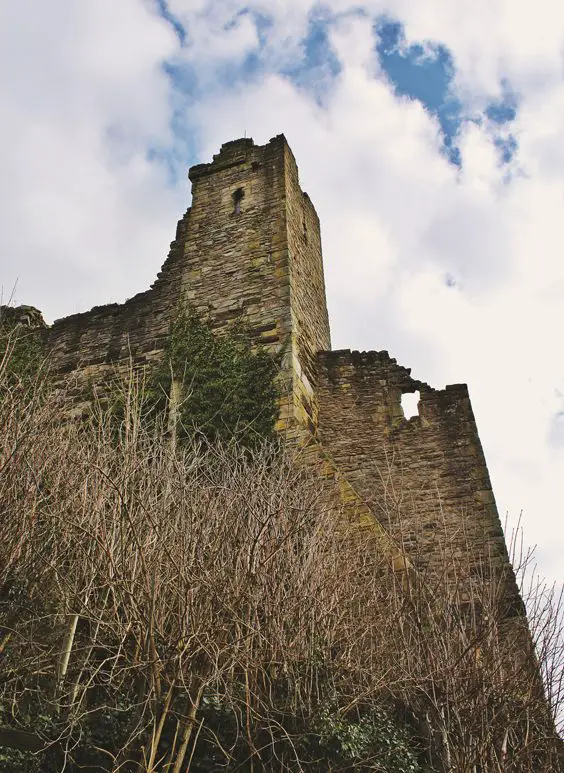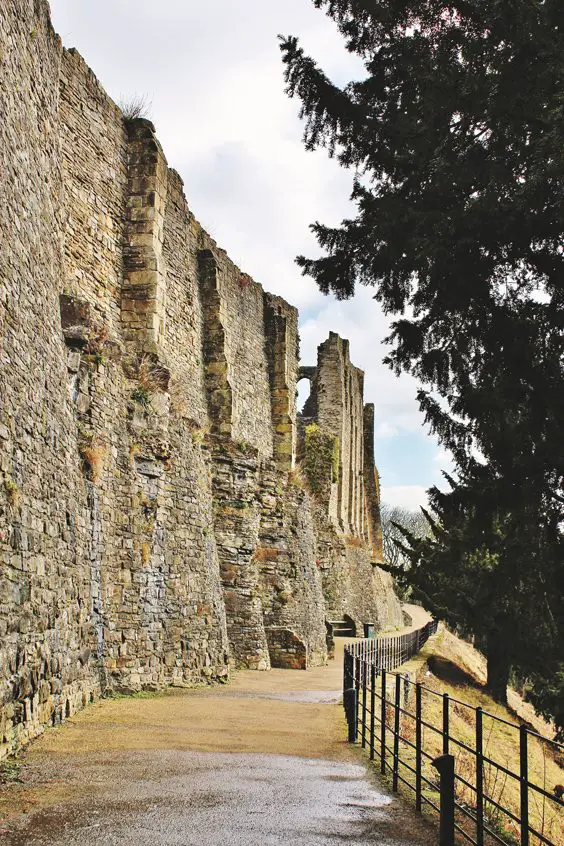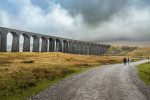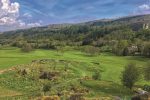Richmond Castle – One of Yorkshire’s Early Stone-Built Castles
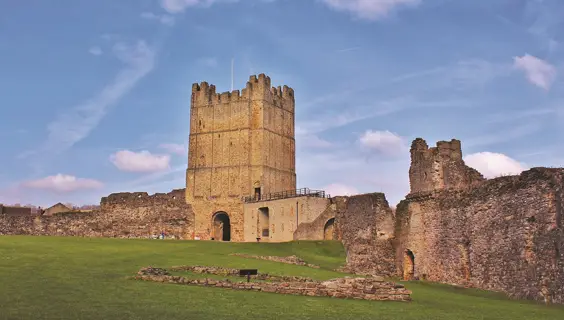
By Andrew Graham Stables
Richmond Castle is one of the earliest stone-built castles in the country and no other in England can boast so much surviving eleventh-century architecture. Count Alan Rufus (the Red) was granted vast lands in the north following his service to William the Conqueror at the Battle of Hastings. Building work is believed to have started soon after 1071 to suppress the recently dispossessed Anglo-Saxon nobility and establish Norman power in the north.
The castle is actually mentioned in the Domesday Book as a ‘castlery’, meaning an ‘estate organised to sustain a castle’. The earliest sections of the castle include some of the curtain wall, the great archway in the ground floor of the keep and Scolland’s Hall. Alan Rufus died in 1093 and the estates passed to his younger brothers, Alan Niger and then Stephen, but by 1136 it was held by Stephen’s son, another Alan, who was the first to be referred to as the Earl of Richmond. Earl Alan married the heiress of the Duke of Brittany, but when Alan died in 1146 before the dukedom became his, it was his son, Conan, who succeeded to this title in the 1164. This put Conan at the head of the two massive domains of Brittany and Richmond.
A castle brings fairs and markets, and so the town soon began to prosper. As early as 1145 the town was made a borough, which conferred some privileges to the burgesses in return for rents. Conan, as the overlord of estates in Brittany and a flourishing English town, is credited with building the keep as a statement of his power. He also betrothed his daughter to Henry II’s fourth son, Geoffrey, with the duchy of Brittany as part of the deal, but Conan died in 1171 when his daughter was only nine years old.
“Dynastic dispute”
Henry II took control of Richmond Castle until the marriage in 1181, when Geoffrey became Duke of Brittany. During this period Henry is recorded as making repairs to the castle and may have actually completed the keep. The south wall of the keep is built on the earlier curtain wall, but its other three walls are of one date. It measures around 100 feet high and due to its slender proportions gives a great impression of loftiness.
The castle also held William, King of Scotland, after he had been captured at Alnwick in 1174 following his sortie via the Eden Valley and over the Stainmore Pass. It is possible the castle was the subject of a siege in 1215 during the revolt against King John and in 1265 when Simon de Montfort rebelled against Henry III but there are no definitive records to confirm this. One story is that King John visited Richmond and during the rebellion against him he ordered the Earl of Chester to demolish the castle of Richmond if he could not hold it. Clearly this destruction was never carried out.
Throughout the thirteenth and fourteenth centuries the castle was subject to a long-running international dynastic dispute. The honour of Richmond was still held by the dukes of Brittany, but the price of enjoying it was obedience to the king of England, while holding their French lands required fealty to the king of France. With the monarchs of the two countries regularly in conflict, allegiance was always divided and difficult to deal with, so the honour and castle were usually held by either the English Crown or a royal favourite. This difficulty continued until 1372, when the castle and honour were finally surrendered to the Crown.
“Fashionable tourist attraction”
Those endowed with the Honour of Richmond over the following years included Ralph Nevill, Earl of Westmorland, Edmund Tudor (whose son became Henry VII), George, Duke of Clarence (brother of Edward IV), and later his other brother, Richard, Duke of Gloucester (Richard III). The result of the ownership dispute and royal connections was the lack of upkeep or alterations during this period. Some work was carried out in 1250 by Henry III and by Edward I after 1294. Though it is unclear exactly what work was undertaken by these two notable kings and the castle proceeded to lapse into a state of disrepair to eventually became a ruin.
In 1535, Leland, described it as a ‘mere ruine’ and in a survey in 1538, described ‘the port lodge, the inner gatehouse, the sware house, the mantill wall and five turrets, the great dongeon, two wells, the hall, pantry, buttery, kitchen and other offices, the privy chamber, a little tower for draughtes, the great chamber, a chapel next it, and a chapel in the castle garth with the masonry and timber much decayed.’
In 1675 Charles II gave it to his illegitimate son Charles Lennox, whom he also created Duke of Richmond, and some essential repairs to the keep were carried out in the 1760s. However, it was the rise in the romantic period of art, which peaked in the early 1800s, that led to something of a revival.
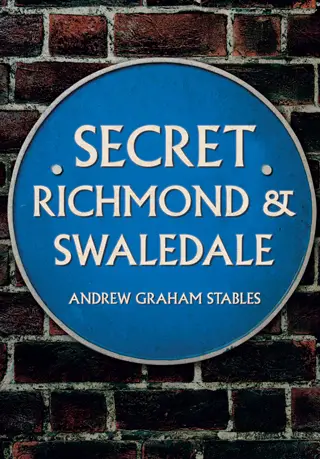 Works by artists like J. M. W. Turner encouraged the idea of the romantic ruin and the town became a fashionable tourist attraction. Some of this was due to the Napoleonic Wars prohibiting the upper class taking a ‘Grand Tour’ of Europe and alternative locations were sought to take the air or to take the mineral waters. The Victorian period saw a return of use for the castle and, at the time of the Crimea War (1853–56), in 1854 the castle was leased out to the North York Militia.
Works by artists like J. M. W. Turner encouraged the idea of the romantic ruin and the town became a fashionable tourist attraction. Some of this was due to the Napoleonic Wars prohibiting the upper class taking a ‘Grand Tour’ of Europe and alternative locations were sought to take the air or to take the mineral waters. The Victorian period saw a return of use for the castle and, at the time of the Crimea War (1853–56), in 1854 the castle was leased out to the North York Militia.
“Symbol of hope”
Within the year a barrack block was built next to the west curtain wall and the keep modified with the addition of a reserve armoury building next to it. By 1908 the castle became the headquarters of the Northern Territorial Army and Robert Baden-Powell, who went on to found the Boy Scouts, commanded for a short time. In 1910, the army handed over the historic sections of the castle to the Ministry of Works, although they retained control of the barracks and armoury. The Victorian barracks were demolished in 1931 but the armoury building was retained.
During the First World War the castle housed conscientious objectors, men who had asked for exemption from military service because it was against their beliefs. Many were Methodists, Quakers and Jehovah’s Witnesses and even socialists. Where some men from these faiths would become medics or orderlies during the fighting, some refused to undertake any work involving the war effort. These men were held in cells at the castle and became known as the ‘Richmond Sixteen’. They were sent to France in May 1916 and were put on trial for refusing to obey orders. They were sentenced to death, but the sentence was eventually commuted to ten years’ hard labour.
The castle and especially its keep have been a symbol of Richmond for nearly 1,000 years and latterly as a symbol of hope even during the Second World War when it was used to watch for enemy activity in the area and the keep was used as an air-raid shelter.
Article taken from ‘Secret Richmond and Swaledale’ by Andrew Graham Stables, published by Amberley Publishing, £14.99 paperback, ISBN: 9781445683911
